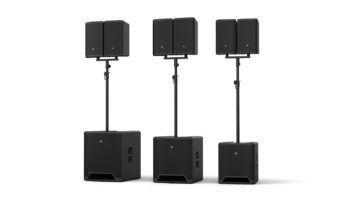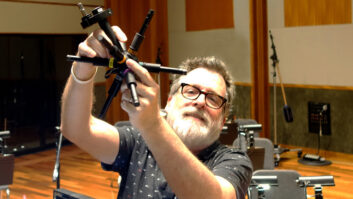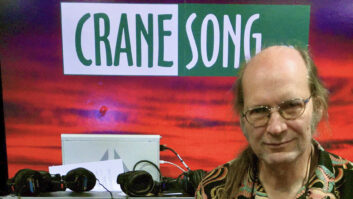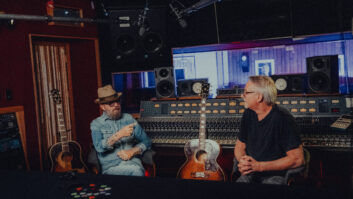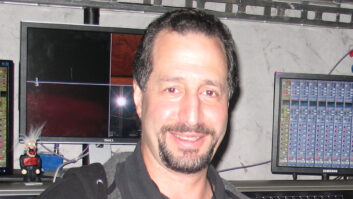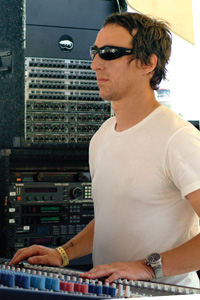
Dave Rat
Photo: Jimi Gianetti
What was the industry like when you started Rat Sound?
Because Rat started off literally with two speakers, an amp and a cassette deck with a “Y” cable as the two mic preamps and mixer, I did not really have a clear view of “the industry” back in 1979. As we grew, though, I began to see the various levels. Most of the companies that I considered large and ominous back then are now defunct, merged or shrunken. I remember providing sound for a small laser tent at the US Festival in 1983. I remember it was kind of a big deal for fierce competitors like Clair and Showco to work together, with Clair on mains and Showco doing delays.
I remember it being a cut-throat business where it was more about people hiring their good-old-boy pals rather than quality gear, service and crew. I remember the frustration of losing gig after gig because Rat refused to pay kickbacks. I remember no one wanting to hire us until we did some big shows that we could not get because we had no big shows under our belt. And I remember that I could go out and cut some plywood and build some boxes and build a speaker cab that was as good or better than just about anything you could buy.
What changes have you seen — for good or bad — since then?
By the late ’90s, Rat was fielding a fully designed “in-house” arena-sized P.A. on U.S. and European tours. I cannot imagine anyone designing a full-blown P.A. system that can compete with the current top manufacturers in today’s market. The days of building a world-class, competitive main P.A. speaker system without a full engineering group, lots of expensive test gear and a hefty budget are over.
That said, you can now buy excellent off-the-shelf products from many manufacturers. Along with the availability of quality turnkey systems, now someone with a bunch of cash can pretty much buy the same gear that is out on top tours. A side effect of the worldwide availability of quality gear is that the old-school “my system is better than your system” mentality is fading. Cross-rentals between vendors like Clair/Showco was practically rare back then, whereas now it is very common for companies to cross-rent equipment. I really like this maturing of the industry.
In addition to running a sound company and keeping involved at FOH, you’ve designed the MicroWedge, which is manufactured by EAW. How did you get from FOH engineer to product designer?
The MicroWedge was designed to solve what I saw as a major deficiency in what manufacturers offer in floor monitors. A small, loud, excellent-sounding wedge that’s attractive and very resistant to feedback was the goal. Historically, floor wedges tend to be an afterthought for manufacturers. I wanted to design a family of products where the primary focus is building the ultimate stage monitor system. The MicroWedge 12 and 15 are just the first two of a full family of over a dozen stage and small-venue products that all work together.
In-ears are very useful and are gaining popularity, but stage monitor systems have some interesting characteristics that in-ears do not. The ability for a musician to alter the sound they hear by where they stand is pretty significant. With a high-quality stage monitor system and well-balanced stage volumes, an artist can immerse in the sound of the bass player or guitar player and freely wander the sonic landscape that’s created onstage. The MicroWedge series of products are designed to provide the tools to create that landscape. Each of the products is designed to be “plug-and-play,” yet is non- or minimally processor-dependent.
The next product coming out is called the MicroWedge Sub 15, which can provide regional low end, act a wedge sub, sidefill sub, drum sub and small-venue sub. The enclosure is really cool and unique, and I am pretty sure it is one of the most versatile subs made.
Where do you see Rat Sound headed?
Rat Sound’s primary focus continues to be concert touring. We do an occasional sound installation if we are asked and the people running the venue are enjoyable to work with. We install the same gear we put on tour, so we keep things well within our world of familiarity. We have a retail sales department, and you’ll never guess — we sell mainly the same gear we tour with! As with the MicroWedge and the Rat Sniffer, and other testers we are designing and offer, it’s all gear that supports the touring side. So I guess we are headed down the same road we’ve been on for almost three decades now.
I well-remember the early days of trying to get ahead only to be pushed aside, so I try and dedicate some of my time to offering the advice I wish I had access to when we were starting up: Never listen to anyone that says it can’t be done.

